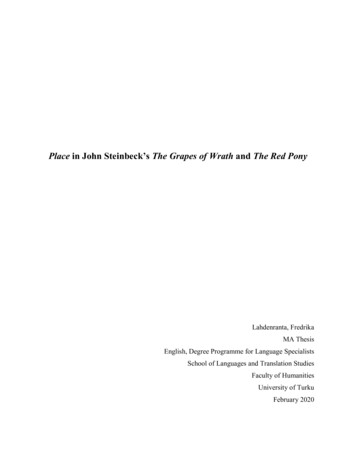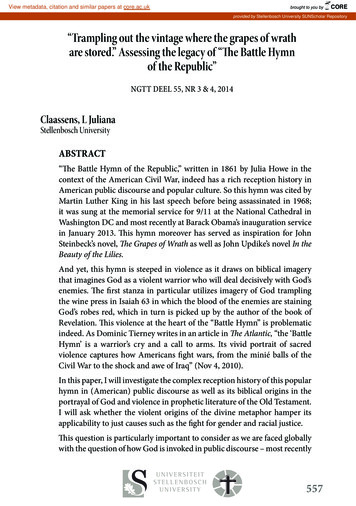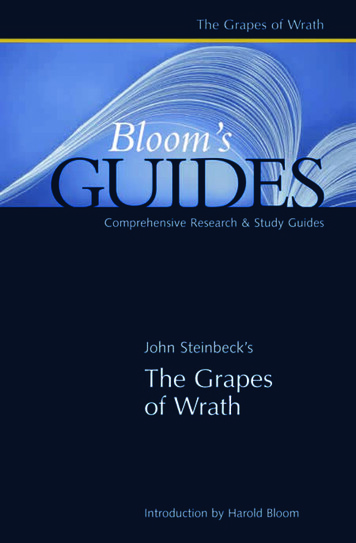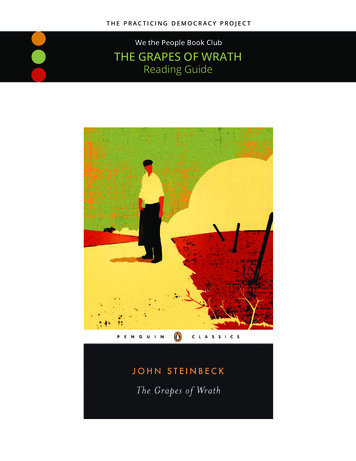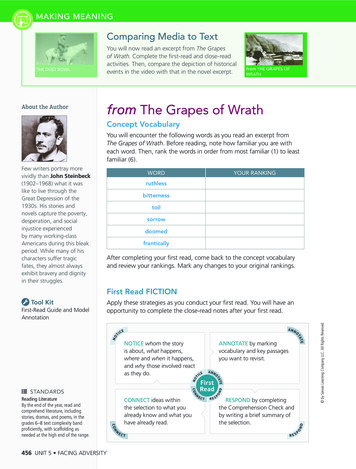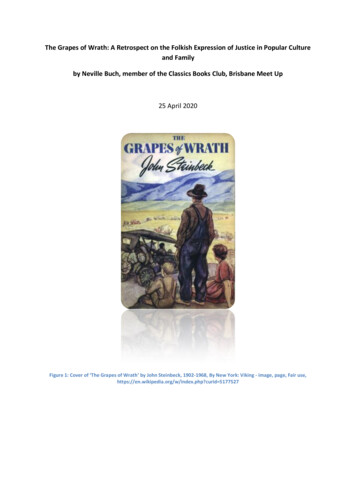
Transcription
The Grapes of Wrath: A Retrospect on the Folkish Expression of Justice in Popular Cultureand Familyby Neville Buch, member of the Classics Books Club, Brisbane Meet Up25 April 2020Figure 1: Cover of ‘The Grapes of Wrath’ by John Steinbeck, 1902-1968, By New York: Viking - image, page, Fair use,https://en.wikipedia.org/w/index.php?curid 5177527
The Grapes of Wrath: A Popular Culture RetrospectINTRODUCTIONThe story of rural folk migrating in times of poverty and social injustice seeped well into mychildhood history, through three popular cultural forms of entertainment:- several televisionseries in the 1960s, a series of comedy films from the late 1940s and 1950s, and a novelpublished in 1939 with a classic Hollywood movie the following year. There was in my ownfamily history points of connection to the longer story, which I would only find out manyyears later. The story told here will move backwards in time, and the historical settings aredifferent; that is the particular point I am making. Different histories are linked by acommon theme, and in this case, we are considering the folkish expression on social justice.Retrospectively, we can also see how popular entertainment works to thin-out the socialjustice message. What starts as a serious educative process of informing the public onimportant social justice issues, in the end, becomes a mocking and light reflection on lifechanging questions. By going backwards, we dig below the surface for the gold, rather thanbeing satisfied in panning for the golden flakes.Figure 2: ‘Ma and Pa’ Buch on the Road Dr Neville BuchPage 2
The Grapes of Wrath: A Popular Culture RetrospectAMERICAN TELEVISION 1954-1973Figure 3: Title screen from The Beverly Hillbillies By Source, Fair use,https://en.wikipedia.org/w/index.php?curid 15993718The Beverly Hillbillies was an American sitcom television series broadcast on CBS from 1962to 1971. The Clampett family are hillbillies from the Appalachia region. The writer of theseries was Paul Henning, who also created the ‘country cousin’ series on CBS: PetticoatJunction and its spin-off Green Acres. Since the 1970s the narrative of rural folkish wisdomagainst urban modernism has never had the same hold on the popular culture. The phrase‘rural purge’ referred to a series of cancellations, at the end of the 1970–71 televisionseasons, in still-popular rural-themed shows of the American television networks (inparticular CBS). The rural-themed television shows had, for the decade of the 1960s, grewinto a cultural obsession. Among the globally well-known family television staples was CBS’sThe Andy Griffith Show (1960-1968, 249 episodes spanning over eight seasons), Mister Ed(1961-1966, 143 episodes), and Lassie (1954-1973, 591 episodes over 19 seasons). JerryHaggins of the Museum of Broadcast Communication captures the reasoning for the purge:By the late 1960s, many viewers, especially young ones, were rejecting [ruralthemed] shows as irrelevant to modern times. Mayberry's [fictional town of NorthCarolina in The Andy Griffith Show] total isolation from contemporary problems was Dr Neville BuchPage 3
The Grapes of Wrath: A Popular Culture Retrospectpart of its appeal, but more than a decade of media coverage of the civil rightsmovement had brought about a change in the popular image of the small Southerntown. Gomer Pyle, U.S.M.C., was set on a U.S. Marine base between 1964 and 1969,but neither Gomer nor any of his fellow marines ever mentioned the war in Vietnam.CBS executives, afraid of losing the lucrative youth demographic, purged theirschedule of hit shows that were drawing huge but older-skewing audiences.1Although the folksiness had the upper-hand, the exchange went both ways. PetticoatJunction (222 episodes in seven seasons) was the linchpin in this larger fictional world. TheShady Rest Hotel was located at a water stop along the isolated branch line of the C. & F.W.Railroad; the line runs between the rural farm community of Hooterville and the small townof Pixley. The main town is a reference to Pixley, California, and the main setting is thoughtto be somewhere in Southwest Missouri. However, it is simply a representation of oldAmerica ‘small-ville’ and the new American television suburbia. It is a nostalgic retreat backto folkish decent values and decision-making, but given a modern sexually-alluring twist. InDrucker's Store, menfolk come to play checkers and chat, and in a carefree environment.Widowed Kate Bradley is the hotel proprietor and is left to keep the community together.Uncle Joe Carson, when he is not in idle pastimes, frequently comes up with half-baked getrich-quick schemes and ill-conceived hotel promotions which end up in foolishpredicaments. The Hooterville Cannonball is a 1890s vintage steam-driven train, running as ataxi service by engineer Charley Pratt and fireman-railway conductor Floyd Smoot. Many ofthe episodes’ storylines hark back to the nineteenth century corporate greed of the railwaybarons. The railroad executive Homer Bedloe continues to make futile attempts to shutdown and scrap the Hooterville Cannonball, along with its isolated track which keeps thispart of rural America connected to the rest of the country. The train stop is nicknamed‘petticoat junction’ (really a water stop) because the Bradley sisters often go swimming inthe railway's water tower and leave their petticoats draped over the side. Kate Bradley’sthree beautiful daughters – redhead Betty Jo, brunette Bobbie Jo, and blonde Billie Jo – arethe modern and urban element in the tale, combining independent feminism and soft-eroticsexuality.Hooterville is the junction in the three-way CBS world. Green Acres (170 episodes in sixseasons) reversed the theme’s direction by a plot in which a New York wealthy ‘mod’couple, Oliver Wendell and Lisa Douglas, move from New York City to a country farm of theshow’s name. This last in the three series opens up the world of television to morecharacters in the Hooterville population; including Fred and Doris Ziffel with their pig‘Arnold’, who are the Douglases’ childless elderly neighbours. The name ‘Oliver Wendell’ is1Jerry Haggins,. ‘The Andy Griffith Show – U.S. Situation Comedy’. Museum of Broadcast Communications. Dr Neville BuchPage 4
The Grapes of Wrath: A Popular Culture Retrospectan allusion to Oliver Wendell Holmes Jr., the famous American jurist who is symbolic of therural-urban crossover during the early twentieth century. The Beverly Hillbillies (274episodes over nine seasons) was the earlier and mainstayer among the three series, butcrossover storylines ties all three parts of the folkish world together. Granny or Daisy MayMoses, Jed Clampett’s mother-in-law comes to Hooterville area to tend to Betty Jo andSteve's baby at the Shady Rest Hotel, Petticoat Junction. The Clampetts also spentThanksgiving and Christmas of 1968 in Hooterville, and in 1970, Miss Jane and Mr. Drysdalealso came looking for billionaire Howard Hughes in Hooterville. The new urban-dwelling‘Beverly Hillbillies’ were not to be separated from their rural homeland. In the reverse ruralurban direction, Oliver Wendell and Lisa Douglas are frequently interacting with thecharacters of Petticoat Junction.Figure 4: The season-three cast of Petticoat Junction in 1966: Sitting on table: Higgins the dog, front row (L-R): LoriSaunders (Bobbie Jo), Bea Benaderet (Kate), and Edgar Buchanan (Uncle Joe), back row (L-R): Frank Cady (Sam Drucker),Gunilla Hutton (Billie Jo), Linda Kaye Henning (Betty Jo), Rufe Davis (Floyd Smoot), and Smiley Burnette (Charley Pratt).Promotional photo of the cast of Petticoat Junction (TV series from the United States), season 3 cast in 1966. ast.jpgThe ‘Beverly Hillbillies’, running longer and with a larger audience, provided the idealmicrocosm for the folkish narrative of the rural-urban crossovers. Jed Clampett, animpoverished and widowed mountaineer, relocates to a Beverly Hills mansion and it’s “Cement Pond”, along with his daughter, Elly May Clampett, and mother-in-law, ‘Granny’ DaisyMay Moses, and Jethro Bodine, the brawny, half-witted son of Jed's cousin Pearl. Jed Dr Neville BuchPage 5
The Grapes of Wrath: A Popular Culture RetrospectClampett’s good fortune has come by way of the oil-rich swamp on his mountain land,whereby OK Oil Company paid Jed for the right to drill on his land, an income estimated at 25 million (equivalent to 211,000,000 in 2019). Added to the railway barons, the oilbarons are background to the story of the larger folkish world. The American economicnarrative is completed with Milburn Drysdale, Jed's greedy, unscrupulous banker. ForMilburn and Margaret Drysdale’s misfortune, the Clampett family ends up being neighbourson the Beverly Hill’s millionaires’ row. The humour for the hillbillies in California – and verydifferent to the humour back-home in Hooterville – is that Los Angeles wants the new-foundriches from the hillbillies but are alienated by their folksy wisdom and ways of seeing theworld. In many of the storylines there is, in the 1960s, a collision between two worlds;however, seeing the funny-side, has helped to defuse what would otherwise be hostile, andmaybe violent. The character of Miss Jane Hathaway, Drysdale's scholarly and ‘plain Jane’secretary, is very important in this regard. Jane Hathaway smooths over the tensions and isthe resourceful worker who ends up fixing the social problems.Figure 5: Eddie Albert and Eva Gabor as Oliver and Lisa Douglas from the television program Green Acres. 17 September1965, https://commons.wikimedia.org/wiki/File:Eddie Albert and Eva Gabor Green Acres 1965.JPG Dr Neville BuchPage 6
The Grapes of Wrath: A Popular Culture RetrospectHOLLYWOOD CINEMA 1947-1957‘Ma and Pa Kettle’ was better known as characters in ten comedy films, but originallycreated by Betty MacDonald in her 1945 best-selling novel, The Egg and I. The ‘Ma and PaKettle’ characterisation are obviously the basis for the characters we find in Beverly Hills andthe Hooterville areas a decade or so later. With only the ten films from 1947 to 1957, theworld of the Kettles provide a sharper narrative, linking the ethos of the American folksy1930s to the far more satirical confrontation of the 1960s. We see in late 1940s and 1950scinema a dynamic mixture of celebrated nostalgia and progressivist relief from materiallypoorer conditions. It was an era greatly troubled by both these ideals and the reality.Figure 6: The Ma & Pa Kettle Farmhouse. Source: Universal Studios By Source, Fair use,https://en.wikipedia.org/w/index.php?curid 26102908In the original The Egg and I (1947) we are introduced to Ma and Pa Kettle through the maincharacters. Betty and Bob MacDonald go to the countryside to follow Bob’s dream to be asuccessful chicken farmer. Ma and Pa background the story as a hillbilly couple with fifteenchildren. In Ma and Pa Kettle (1949), or ‘The Further Adventures of Ma and Pa Kettle’, theolder couple have lived in a broken-down ramshackle farmhouse for twenty-five years in Dr Neville BuchPage 7
The Grapes of Wrath: A Popular Culture Retrospectrural Cape Flattery, Washington. The Kettles' arch-nemesis, Birdie Hicks, organises a towncouncil meeting to condemn the Kettles' ‘garbage dump’ farm. In order to receive a newtobacco pouch for entering a contest, Pa Kettle writes a slogan for the King Henry TobaccoCompany. Pa Kettle is declared the winner of the contest's grand prize of a new ‘house-ofthe-future’, but, after Pa abandons his new home life, full of puzzling gadgets, and also withaccusations over plagiarising the wining slogan, a major slap-stick battle enthuses to savethe Kettles’ new home. The plot hangs on the misunderstanding between folksy wisdomand the Madison Avenue’s sell of the modern American home life. It is centrally conveyedthrough the interaction between Kettles' oldest and college-educated son, Tom, and a ‘mod’magazine writer, Kim. Tom is the rural technical innovator with plans to improve a chickenincubator, and he objects to Kim’s characterization that the Kettle upbringing had been oneof ‘abject’ poverty. The film challenges the thinking on wealth, between folksy wisdom andAmerican commercialism.In Ma and Pa Kettle Go to Town (1950) Pa has won another jingle-writing contest, this onefrom the Bubble-Ola Company. Ma and Pa are only able to take up the prize of all-expensespaid trip to New York City, when a fleeing bank robber, Shotgun Munger, convinces Pa thathe is an eccentric poet, ‘Mr. Jones’, and he could look after the kids at the farm. The farmgives Munger a hideout from the police and he is also able to convince Pa to deliver a bag(of hidden loot) to his ‘brother’ Louie in New York. The New York setting becomes the comicroutine of the classic ‘switching bags’ and crossing between the great sites of themetropolis. The newly-wedded Tom and Kim, now living in New York, are on-hand toprovide a new world perspective of the early 1950s. As a reward for Tom’s and Kim’smodern decency, the plot ends with a wealthy investor, caught up in the comic routine,agreeing to finance Tom’s chicken incubator. Meanwhile, Munger, so overwhelmed by the14 wild Kettle children, welcomes arrest by the police in order to be protected from therural mayhem. The question of what is wealth has continued from the second film but, witha crime plot, there is a question of who deserves wealth. Like most American situationcomedy, the messages are somewhat mixed. Crime in urban New York inadvertently led todeserved wealth, and on the flipside, crime out in countryside was punished by the hoodlumactions of rural children.The clashes of worldviews come thick and fast in Ma and Pa Kettle Back on the Farm (1951).Kim is pregnant with the first child in July 1950. Kim’s parents, Jonathan and ElizabethParker, refined Bostonians, have arrived at the doorstep (still assumingly, Cape Flattery,Washington). In order to accommodate the Parkers, the Kettles’ provide them with theirultra-modern house (the prize in the earlier story) and returned to their beloved ramshacklefarmhouse. Two sub-plots arise. The side-story is about Pa and his Native American friends,Geoduck and the mute Crowbar, searching out the wealth of uranium deposits after a Dr Neville BuchPage 8
The Grapes of Wrath: A Popular Culture Retrospectradioactive incident when digging a well. It proves to be farce when it is discovered that theonly radioactive element on the property is Pa's coveralls, from an unrelated source. Theobvious storyline is the feud between the older Parkers and Kettles, creating tension inTom’s and Kim’s marriage at the moment of their first born. The story also comes with theclassic switching babies’ routine. However, each older parent comes to save day for theother family. Mr. Parker, a retired mine owner, saves the farm from being lost to swindlerswho are after the phantom uranium deposits. Ma Kettle and Elizabeth Parker make up theirdifferences and are able to work together; the marriage is saved when Kim and Tom asserttheir independence from the in-laws, and peace and harmony is celebrated for both familiestogether in a grand old farm dinner. The fourth film unpacks the question of wealth in familyvalues. The story of uranium deposits challenges one of the great rural mythologies, that of‘land settlement’. In the end, the value of the land was not its material wealth, but as aplace where family peace and harmony could be found. Here there is a tragic irony in theroles of Geoduck and Crowbar.Figure 7: Original film poster By Universal Pictures (The original uploader was 17Drew at English Wikipedia.) (Transferred from en.wikipedia to Commons by Stef48 using CommonsHelper.), Public urid 4724396 Dr Neville BuchPage 9
The Grapes of Wrath: A Popular Culture RetrospectWhen we arrive at the fifth film, Ma and Pa Kettle at the Fair (1952), the series appears tobe digging further into American rural history. Poverty is front and centre. Ma and Pa Kettleare trying to raise money to send their daughter Rosie to college, although the couple arenow unemployed and in debt. Pa deliberately walks in front of street traffic, hoping to win amonetary injury settlement, but only succeeds in causing a collision. Ma then decides toparticipate in contests at the county fair, and Pa buys Emma, an old tired horse, on credit forthe Harness Race, promising to pay the owner later with Ma's fair prize winnings. Thenemesis Birdie Hicks tries her best to win all of the contests, but the Kettles are the oneswho get the last laugh. The sixth film, Ma and Pa Kettle on Vacation (1953), returns totheme of the New York film, but on a grander scale. In May 1953, Ma and Pa Kettle aretaken on a trip to Paris, France, by Jonathan and Elizabeth Parker; rural and urban Americanfamilies are now in full harmony. As with the New York film, there is a crime plot, but with amysterious envelope rather than a bag of loot. The Kettle children are left in the care ofNative American friends. By this stage in the film series, the comedy has settled into shallowfarce with little plot development. In Ma and Pa Kettle at Home (1954), it is December 1953,and Ma and Pa have returned to the old farm. Another son, Elwin Kettle, has his contestletter, whereby he will find a prized scholarship if two judges of National Magazine wouldevaluate the ramshackle farm as a winner. With Ma and Pa Kettle at Waikiki (1955), it is July1952, and the Kettles help out Cousin Rodney Kettle in Hawaii with his pineapple business.Ma and Pa get acquainted with blue-blooded Mrs. Andrews who thinks the Kettles are the‘lowliest’ people she has met. Farce is now thin prejudice. The Kettles in the Ozarks (1956) isanother crime plot and touring film. This time, with Pa’s absence, Ma and the kids head outto help Pa's brother Sedgewick with his farm in Mournful Hollow, Arkansas. Things gettighter when a couple of bootleggers rent Sedge's barn to manufacture moonshine. WithMa and the kids, the bootleggers get their folksy justice. One can see the creep of the early1950s Hollywood moralism in this film. The final film, The Kettles on Old MacDonald's Farm(1957), hits rock-bottom with thin plot development and antiquated moral attitudes – Maand Pa help Brad Johnson to turn his girlfriend Sally into a good farm wife. What started ascomedy with serious messages of rural-urban valuing becomes a caricature of a caricature.It is the basis for the satirical hillbillies in Beverly Hills.THE HISTORY OF ‘THE GRAPES OF WRATH’ 1861-1968The Grapes of Wrath is an American realist novel written by John Steinbeck and published in1939. As such, it contrasts much better to the degenerating entertainment seen ontelevision and cinema from the late 1940s. The storyline is framed by one chapter of theGreat Depression Years (discussed further on). The ‘Dust Bowl’ was a period of severe dust Dr Neville BuchP a g e 10
The Grapes of Wrath: A Popular Culture Retrospectstorms that greatly damaged the ecology and agriculture of the American and Canadianprairies during the 1930s. The ideas of land and farming are part of the story but the novel isreally focused on human affairs caught in battles of an emerging political world. In the noveland film version, the social salvation found in the kinder Federal Department of Agriculture'scamp for the Californian ‘Okies’ speaks of that history (discussed further on). 2 The humanaffair lies at two levels, that of a family, and that of friendship in a labouring brotherhood.The family is the Joad, who are forced off their farmland in Sallisaw, Oklahoma, from boththe impact of the Dust Bowl and the emerging new farming technologies with its ruraleconomics. The environmental story is complex with the exploited and the exploiterscoinciding. The older generation, Grandpa and Grandma, died on the migrating journey toCalifornia. The old world has perished, and its members do not make it to ‘the promisedland’. The family is held together, for the whole novel, by Joad family matriarch, Ma. TheRoute 66 or Will Rogers Highway (opened in 1926), and sometime called the ‘Mother Road’,is the pathway of the Okies’ migration, and, with the arrival of the Steinbeck novel, anAmerican cultural icon was created. The road story is sandwiched by the fraternity betweenTom Joad and Jim Casy, first in Oklahoma, and then in California. Casy, an ex-preacher, is ananarchist-kind of Christ figure. The stories of the Okies rural labourers in the fruit-pickingland become the first bloodied battle in an American war for economic social justice. It isthe West Coast story to the East Coast story of the Bonus Army clash of 1932.Figure 8: Henry Fonda as Tom Joad. The Grapes of Wrath film still. Original trailer of the film "The Grapes of Wrath"(1940). https://en.wikipedia.org/wiki/File:The Grapes of Wrath (1940) - Trailer.webm#metadata2The better and kinder camp environment was Weedpatch Camp, one of the clean, utility-supplied campsoperated by the Resettlement Administration, a New Deal agency. It’s a symbol of Federal intervention toprotect Americans against the discriminatory claims of ‘State Rights’. It parallels the same type of federalintervention in the Eisenhower-Kennedy administrations, later, to protect the civil rights movement from theattacks of ‘State Rights”. Dr Neville BuchP a g e 11
The Grapes of Wrath: A Popular Culture RetrospectThe film version of Steinbeck’s Pulitzer Prize-winning novel followed very quickly; thescreenplay was written by Nunnally Johnson, and directed by John Ford. Although the filmchanged the plot sequences and drops much of the descriptive imaginary of Steinbeck, ithas remained a cinematic classic because it captured Steinbeck’s Rural Labourite ‘speeches’of the novel. The ‘speech’ devise are segments of dialogue where the writer has a boldmessage for the audience (discussed further on). The original reference in the title is theBook of Revelation, chapter 14, verse 19: “The angel swung his sickle on the earth, gatheredits grapes and threw them into the great winepress of God’s wrath.” The reference also hadcreep into American nationalist mythology. The ‘Battle Hymn of the Republic’ (1861) by JuliaWard Howe stated in the first stanza:Mine eyes have seen the glory of the coming of the Lord;He is trampling out the vintage where the grapes of wrath are stored;He hath loosed the fateful lightning of His terrible swift sword:His truth is marching on.Mary Harriott Norris, an American writer, had already produced the novel’s title in 1901. Forall that nationalistic imagery, however, Steinbeck’s novel (and the film) is a condemnation ofthe nation’s domestic and terrifying violence. In contrast to most of the historical messagingof the American Civil War; except for Lincoln’s ‘A House Divided’ speech (‘I believe thisgovernment cannot endure permanently half slave and half free’, 1858), Steinbeck’simaginary of ‘The Grapes of Wrath’ is better understood in the political ‘war’ of theAmerican Great Depression Years. You would have to be cognitively isolated, as a rabidAmerican conspiracy theorist, not to see the mantle of the Republican Abe Lincoln (16th U.S.President, 1861-1865) being passed onto the Democrat Franklin Roosevelt, in the story ofpulling the nation together. President Herbert Hoover (31st, 1929-1933) was too caught inthe collapsed world of the New York Stock Exchange to understand the new politicaleconomic contract that was required. President Franklin D. Roosevelt (32nd, 1933-1945)presented a ‘New Deal’, a new social contract. And that was where the battlelines weredrawn in the United States. Like the Southern Democrats of the American Civil War, themilitant wing of the Republican Party in the 1930s was out of touch with new social,political, and economic realities. Dr Neville BuchP a g e 12
The Grapes of Wrath: A Popular Culture RetrospectFear and alienation in their collapsing world drove many of these Americans to violenceagainst other Americans who were fighting for survival. Roosevelt and his administrationwere consistently attacked with ridiculously racist conspiracy theories, the very same asthose of the National Socialist German Workers' Party in these same years. The same racialtheories were considered in the late nineteenth century as the height of social science andsophisticated conversation. That it became politically untenable in the United States wasdue to the ‘New Deal coalition’ (1932-1968), a coalition that included the Democratic stateparty organizations, city machines, labour unions, blue collar workers, ‘minorities’ (includingJews, Southern and Eastern Europeans, and African-Americans), farmers, white Southerners,people on relief, and intellectuals. Except for the pro-New Deal Republican President DwightD. Eisenhower (34th, 1951-1961) and his moderate Republican supporters, conservativeAmerica continued to lose the plot in the 1950s; in what Richard Hofstadter described asAnti-intellectualism in American Life (1963), and his essays collected in The Paranoid Style inAmerican Politics (1964). Hofstadter’s historiography was known as ‘Consensus History’,which emphasised the basic unity of American values and the American national characterand downplayed conflicts, especially conflicts along class lines. This is where Steinbeck’simaginary of ‘The Grapes of Wrath’ for the 1930s and 1940s plays an important role inAmerican history more broadly. Steinbeck, unlike Hofstadter, draws out the class lines, butSteinbeck too is creating a consensus view for the American people, based on folksymorality with a concept of decency.Figure 9: The Grapes of Wrath film still. Original trailer of the film "The Grapes of Wrath" (1940).https://en.wikipedia.org/wiki/File:The Grapes of Wrath (1940) - Trailer.webm#metadata Dr Neville BuchP a g e 13
The Grapes of Wrath: A Popular Culture RetrospectThe speeches of the novel and the film are the intellectual documents in this way ofthinking. One dialogue is particularly revealing. It comes towards the end of the novel, whenTom has to leave the family to protect them from the lawful consequences of his brutalcrime – as revenge for Casy’s unlawful killing:"I thought maybe you could go to a big city. Los Angeles, maybe. They wouldn' neverlook for you there.""Hm-m," he said. "Lookie, Ma. I been all day an' all night hidin' alone. Guess who Ibeen thinkin' about? Casy! He talked a lot. Used ta bother me. But now I beenthinkin' what he said, an' I can remember—all of it. Says one time he went out in thewilderness to find his own soul, an' he foun' he didn' have no soul that was his'n.Says he foun' he jus' got a little piece of a great big soul. Says a wilderness ain't nogood, 'cause his little piece of a soul wasn't no good 'less it was with the rest, an' waswhole. Funny how I remember. Didn' think I was even listenin'. But I know now afella ain't no good alone.""He was a good man," Ma said.Tom went on, "He spouted out some Scripture once, an' it didn' soun' like no hellfireScripture. He tol' it twicet, an' I remember it. Says it's from the Preacher.""How's it go, Tom?""Goes, 'Two are better than one, because they have a good reward for their labor.For if they fall, the one will lif' up his fellow, but woe to him that is alone when hefalleth, for he hath not another to help him up.' That's part of her.""Go on," Ma said. "Go on, Tom.""Jus' a little bit more. 'Again, if two lie together, then they have heat: but how canone be warm alone? And if one prevail against him, two shall withstand him, and athree-fold cord is not quickly broken.'""An' that's Scripture?""Casy said it was. Called it the Preacher.""Hush—listen.""On'y the wind, Ma. I know the wind. An' I got to thinkin', Ma—most of the preachin'is about the poor we shall have always with us, an' if you got nothin', why, jus' fol' Dr Neville BuchP a g e 14
The Grapes of Wrath: A Popular Culture Retrospectyour hands an' to hell with it, you gonna git ice cream on gol' plates when you'redead. An' then this here Preacher says two get a better reward for their work.""Tom," she said. "What you aimin' to do?"He was quiet for a long time. "I been thinkin' how it was in that gov'ment camp, howour folks took care a theirselves, an' if they was a fight they fixed it theirself; an' theywasn't no cops wagglin' their guns, but they was better order than them cops evergive. I been a-wonderin' why we can't do that all over. Throw out the cops that ain'tour people. All work together for our own thing—all farm our own lan'.""Tom," Ma repeated, "what you gonna do?""What Casy done," he said."But they killed him.""Yeah," said Tom. "He didn' duck quick enough. He wasn' doing nothin' against thelaw, Ma. I been thinkin' a hell of a lot, thinkin' about our people livin' like pigs, an'the good rich lan' layin' fallow, or maybe one fella with a million acres, while ahunderd thousan' good farmers is starvin'. An' I been wonderin' if all our folks gottogether an' yelled, like them fellas yelled, only a few of 'em at the Hooper ranch—"Ma said, "Tom, they'll drive you, an' cut you down like they done to young Floyd.""They gonna drive me anyways. They drivin' all our people.""You don't aim to kill nobody, Tom?""No. I been thinkin', long as I'm a outlaw anyways, maybe I could—Hell, I ain'tthought it out clear, Ma. Don' worry me now. Don' worry me."They sat silent in the coal-black cave of vines. Ma said, "How'm I gonna know 'boutyou? They might kill ya an' I wouldn' know. They might hurt ya. How'm I gonnaknow?"Tom laughed uneasily, "Well, maybe like Casy says, a fella ain't got a soul of his own,but on'y a piece of a big one—an' then—""Then what, Tom?""Then it don' matter. Then I'll be all aroun' in the dark. I'll be ever'where—whereveryou look. Wherever they's a fight so hungry people can eat, I'll be there. Whereverthey's a cop beatin' up a guy, I'll
The Grapes of Wrath: A Retrospect on the Folkish Expression of Justice in Popular Culture and Family by Neville Buch, member of the Classics Books Club, Brisbane Meet Up 25 April 2020 Figure 1: Cover of ZThe Grapes of Wrath [by John Steinbeck, 1902-1968, By New York: Viking - image, page, Fair use,


